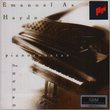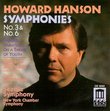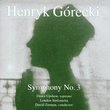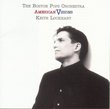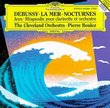| All Artists: Robert Schumann, David Zinman, Zurich Tonhalle Orchestra Title: Robert Schumann: Symphonies Nos. 1-4 Members Wishing: 0 Total Copies: 0 Label: Arte Nova Classics Release Date: 3/22/2005 Genre: Classical Styles: Forms & Genres, Symphonies, Symphonies Number of Discs: 2 SwapaCD Credits: 2 UPC: 723721079253 |
Search - Robert Schumann, David Zinman, Zurich Tonhalle Orchestra :: Robert Schumann: Symphonies Nos. 1-4
 | Robert Schumann, David Zinman, Zurich Tonhalle Orchestra Robert Schumann: Symphonies Nos. 1-4 Genre: Classical
"Excellence at this level serves only to renew our faith both in the vitality of the classics and in the ability of today's interpreters to triumphantly stand toe to toe with the greatest recorded documents of the past." (... more » |
Larger Image |
CD DetailsSynopsis
Album Description "Excellence at this level serves only to renew our faith both in the vitality of the classics and in the ability of today's interpreters to triumphantly stand toe to toe with the greatest recorded documents of the past." (10/10 rating!)-CLASSICS TODAY "In this cycle of the Symphonies with the Zurich Tonhalle Orchestra, Zinman reveals Schumann every bit as great as his friends Mendelssohn and Brahms and nearly as great as his idols Schubert and Beethoven. In Zinman's hands and as realized by the Zurich Orchestra, Schumann's First is charming and courageous, his Second is darkness and fright, his Third is awe and delight, and his Fourth is darkness to light. The Zurich Orchestra plays with a strong, warm tone and deep, radiant colors. Arte Nova's sound is richly detailed and lushly reverberant. One of the great Schumann cycles. Anyone who loves Schumann's music or German Romantic symphonies will love these discs." -ALL MUSIC GUIDE Similarly Requested CDs
|
CD ReviewsZinman and the Zurich Tonhalle Shine in Schumann J Scott Morrison | Middlebury VT, USA | 03/22/2005 (5 out of 5 stars) "As a great admirer of American conductor David Zinman I looked forward to this set that comprises his second set of complete Schumann symphonies. He had recorded them some years ago when he was music director of the Baltimore Symphony, and now he has recorded them again with his current orchestra, the Zurich Tonhalle. Music-lovers were set on their ears (inelegant phrase, that, in a music review, eh?) by the Zinman/Tonhalle complete Beethoven symphonies, and I suspect there may be some of the same reaction to this set. It is certainly different from his earlier traversal. And it is almost a polar opposite from the recently released Barenboim/Berlin Staatskapelle set; I state my preferences here--I don't much like the high cholesterol Barenboim set, which strikes me as fustian. There will be those who disagree, but at least you know my prejudices at the outset. This set seems to be saying to us that Schumann was a trailblazer rather than a keeper of an sacred flame. The things that strikes me throughout the four symphonies is how much Zinman treats Schumann's music with a combination of both ardor and momentum. Tempi are faster than we are perhaps used to but there is an intensity of musical utterance that prevents those tempi from sounding light or frivolous. This is a young man's music. The 'Spring' Symphony, No. 1, was written quickly, in only a few days, and its argument is the quintessence of the awakening of not only the spring season but of a young person's passion. This is particularly evident in the headlong Scherzo which sweeps us along in its high spirits. One should note that Schumann wrote the symphony during the last days of winter and one can hear his eagerness for the warm breezes that would urge blossoms to burst forth. When we arrive at the finale, marked Allegro animato e grazioso, we feel the relief that comes when spring is truly here. Zinman and his band catch this feeling precisely. The Second Symphony contains what for me is the most glorious orchestral music Schumann ever wrote: the third movement, marked Adagio espressivo. It can be played meltingly, even languorously, as Sinopoli does in his account, or rather solemnly as Barenboim does in his. Schumann wrote the symphony when he was in the midst of a depression and some commentators hear a melancholy in its strains. Not I. I hear nothing but a glorious song, one of great calm and serenity. And yet there is an undercurrent of uneasiness that suggests the calm may not be as deep as one might wish. And that is exactly what Zinman's version conveys. He does not swoon or moon over the delicious melodies of the movement. He does not over-accentuate that marvelous chain of trills in the high violins. He keeps moving. At first I was not sure I liked this approach, but the more I listened the more I began to feel that other versions were perhaps a bit maudlin, even goopy. The Tonhalle play as gorgeously here as one could possibly wish. There have been times when I felt, in other recordings, their strings were a bit thin, but not here. This is Romantic music played with a clear eye and no self-pity. [One notices, in that wonderful third movement, that Zinman allows his principal winds, as he had in some of the Beethoven symphonies, to add their small presumably improvised ornamentations to semi-cadences. Whether this is accurate performance practice of Schumann's time or not, it adds charm to the reading.] The 'Rhenish' Symphony No. 3 is probably Schumann's happiest work. Four of the five movements abound with the joy of living. And probably they reflect Schumann's own happiness at the move he and Clara had made to Düsseldorf (on the Rhine) where he became the city's director of music. The symphony makes much use of dance rhythms and an outpouring of melody only exceeded in Schumann's lieder. The fourth movement, which seems slightly at odds with the merriment of the other movements, is a solemn chorale-like piece which features expert (and tuneful) counterpoint, but its meaning is not clear. Obviously he meant something by it, otherwise he would not have inserted it into the usual four-movement form of the usual symphony. It has been speculated that it commemorates an impressive ceremony, witnessed by Schumann, in which a cardinal was ordained. It is a beautiful piece of music, whatever its purpose within the overall form of the symphony. The fifth movement is cheerfully contrapuntal and quotes several themes from earlier movements. It gathers steam and ends the work in a celebratory mood. The Fourth Symphony was actually the second Schumann wrote, dating from back in Leipzig and written for the Gewandhaus. But it was not well-received at its première and Schumann did not have the opportunity to publish it until much later after some revision, hence its numerical designation. Although in the usual four movements the score directs the conductor to take only a small rest between the movements and indeed it has the feel of a one movement work. It is a serious work whose portentous introduction announces that important things will be discussed. This is the symphony that most commentators refer to most when they mention Schumann's 'poor orchestration.' And many conductors have prepared their own re-orchestration of this symphony, with many alterations. (There is a recording by the Bergen Philharmonic under Aldo Ceccato of all four symphonies in Mahler re-orchestrations.) Serious though it be, Schumann's ability to dance and sing is in ample evidence. Zinman seems to see the work as less forbidding or serious than, say, Furtwängler and this is to the good. Further, his approach, using the original orchestration, lightens whatever muddiness that can accrue when solemn approaches are used. Perhaps there is a lesson in this. Perhaps it's not a serious as one has thought. This set appears to be a new look at the Schumann symphonies. Zinman invests the works with a life and ardor not often heard in them; there are no clotted harmonies, no turgid rhythms. The Tonhalle plays brilliantly. Recorded sound is excellent. This is a wonderful set made all the more wonderful by the obscenely low asking price. Even if you own other sets of these works, you owe it to yourself to get this one. An unqualified recommendation. Scott Morrison" Schumann in Bite-Size Bits JMB1014 | USA | 05/17/2006 (3 out of 5 stars) "I read the superlatives about this set and ordered it. It has very precise sound, very precise playing and it is all just so tidy and neat I can't enjoy it. The music lacks sweep, grandeur and passion. It seems to be measured out into bite-sized pieces or maybe teaspoons, a la Prufrock. Every digitized bit is precise, serially neat and easily digested, meaning the music lacks continuity and sweep - yes, sweep. I feel I am reading a book intended for a seventh-grader. I suppose one could get away with playing Haydn this way, but not Schumann. I will make the ritual recitation that I am familiar with von Karajan's set, Gardiner's, Muti's, Bernstein's second set, Szell's, Solti's, as well as Sawallisch's. Sawallisch is still my favorite, by far. Sawallisch brings you music that is voluptuous and glorious in its romanticism and accomplished musicality. I can't imagine any among the available crop of renditions making Schumann himself happier than Sawallisch's might, with the Dresden Staatskapelle - a precise but powerful instrument. Playing his set is like finding a long-lost lover. On a gorgeous spring day, full of promise and sunshine, Sawallish's Rhenish symphony takes me as far as recorded music can toward the world Schumann rendered into music. Zinman is a gifted conductor and his set is well-recorded but I don't want to play it any more. I'm glad it was not expensive." Bracing Schumann: poetry + poise + heart Dan Fee | Berkeley, CA USA | 12/03/2005 (5 out of 5 stars) "Anyone who has heard and appreciated Zinman's complete set of the Beethoven Symphonies with the Tonhalle Zurich, will get the point of this new issue, a complete set of the four Schumann Symphonies, again with the Tonhalle.
Zinman isn't afraid of setting tempos whose speeds are more commonly met by period instrument groups. As with the Beethoven readings, he uses newly edited sources, and plays everything to the hilt. The Tonhalle seems quite reduced in size in these recordings, such that strings zip along in an altered balance with brass and with woodwinds, compared to the older, slower, heavier performance manner most world orchestra's inherited from the nineteenth century bands (who tended to play in larger and larger halls as time passed and the middle class flocked to concerts as to social occasions). Any past muddiness in the orchestral texture simply disappears in this edition. This clarity of texture is enhanced further with the genius of Zinman's verve. In some passages, chamber music textures are easily achieved, making you revise your opinions of Schumann's orchestral genius. Even going full tilt, Zinman keeps the touch light and lively and agile. You feel as if you are meeting the young Schumann for the first time, especially as the First Symphony takes off. He has a glint in his eye, does this fellow. Small wonder that Clara's father realized he'd better rope off this visitor a bit around his daughters. This is the kind of Spring season that makes you want to leave the house, without a coat, finally unencumbered by winter. Let fall, all cold weather reticence, and heavy clothing. Depending on just how young you feel, this first symphony may make you want to strip down further, just to feel the Spring breezes on your skin in places where polite musical conversation isn't exposition, but falls back into a murmur, musing out loud about nothing and everything lovely in particular. Fortunately, even with all this lightness and the reduced size of the Tonhalle, there is still enough weight to make the stronger musical points, though without the kinds of heavy, Romantic indulgence we have sometimes accepted as the norm. Indeed the alleged heaviness of Schumann's orchestrations is nowhere in evidence here. A quicksilver metamorphosis inhabits this music, and Zinman almost uniquely let it play among the high gifts of each department of the Tonhalle orchestra. Continuing through the remaining three symphonies, Zinman just keeps making fresh magic in his performances of each of the remaining three. The second symphony's slow movement (for example) isn't the least bit ponderous, but doesn't lose one ounce of its lyrical heart in the alchemical process of its lightening. In fact, with the more transparent orchestral textures Zinman crafts with his marvelous Tonhalle players, you hear many passing moments of felicity in woodwind or string phrasing. These moments are there, too, in the older, heavier performances; but just easier to hear with Zinman. Can it be that Zinman will help you hear and re-hear your older Romantic readings of these symphonies? Seems possible, if you pay attention to the lessons he is teaching. With the Third Symphony, Zinman manages to bring more shadow, more seriousness to phrasing. Tempos slow down, ever so slightly, so that maestoso can be conveyed, rhetorically. Zinman and band also pass the critical feierlich test in the odd movement, said to have been evoked on the occasion of a holy elevation of an archbishop at Cologne Cathedral. Throughout the horn and brass are burnished, with solos that carry drama and narrative substance. While in the first two symphonies the horns and trombones were blended more with the other brass and woodwinds, their special Solemnity is captured here, even with reduced forces. The slow movement, preceeding the feierlich one, is another miracle of musical inflection and phrasing, without for one second sounding indulgent or mannered. The spirit of chamber music is revealed in this music, every bit as much as the spirit of the symphony. The Fourth Symphony provides a fitting conclusion to the set. I found myself wishing that Schumann had had more confidence in himself as an orchestral composer, so fetching is the music made throughout this set of four. Who wants it to end? But end it does, with Schumann setting out the ground rules for innovative cyclical form in music; lessons not lost on many of his contemporaries and descendants. As it happens, the added maestoso touches heightened in the second and third symphonies, continue into and throughout the Fourth. The tempo changes no longer seem so awkward, and a contrapuntal depth of story consistently emerges via the enabling consensus of the players. Truly, there are other valid approaches to Schumann. I will still return to the shelf where sit older, prized red book CD performances. Sinopoli and Vienna doing the Second Symphony. Haitink and the Concertgebouw doing all four. And, can it be? Zinman and Baltimore on pre-SACD Telarc show how to play these symphonies with something like the old, burning Romance. I also listen to Solti, Kubelik, Karajan, Klemperer, Mehta - and as they become available again, James Levine with the Philadelphia Orchestra. The nice thing is, at this price, you really don't have to do without much except maybe a few pricey Lattes, just because you purchased this set. The sound is good enough to completely get out of the way of the music, letting you hear everything Zinman and Tonhalle are doing. The hall isn't especially present, except in those larger moments when it resounds, and the venue point is made. Five stars, stars, stars, stars. Highly recommended. Do check out the earlier Zinman with Baltimore, now newly released on midpriced Telarc. And do look out for James Levine/Philadephia as they re-appear." |

 Track Listings (8) - Disc #1
Track Listings (8) - Disc #1